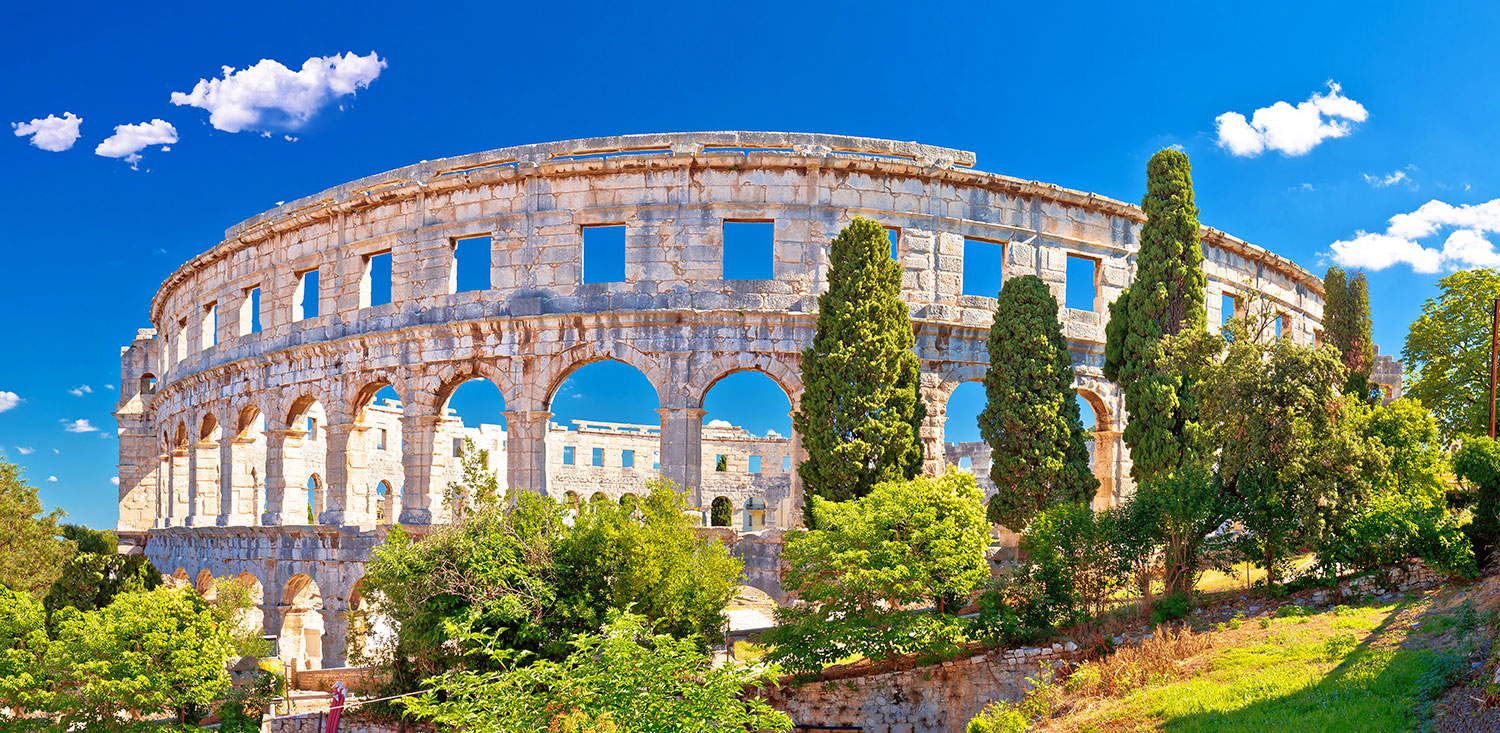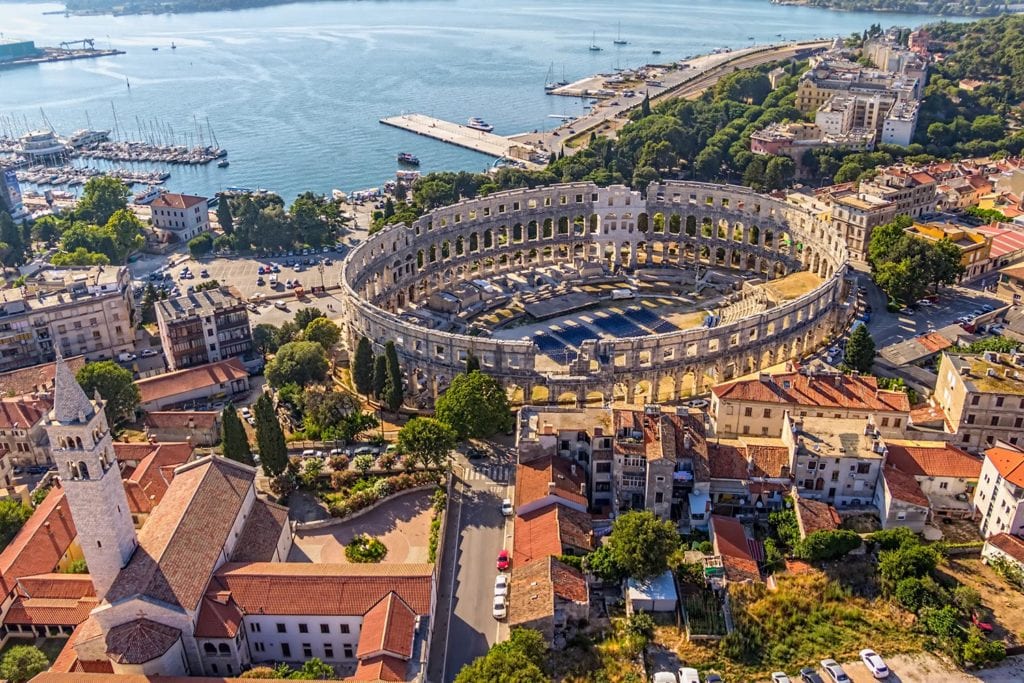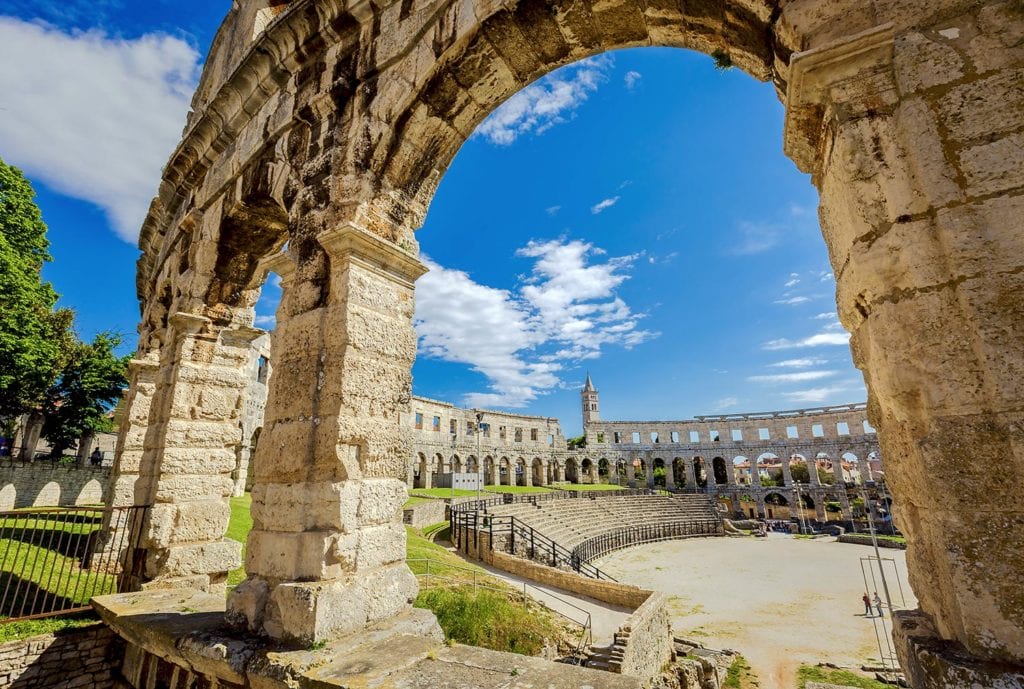Discover the timeless charm of the Pula Arena, Croatia's Roman relic where history speaks through weathered stones and captivating echoes of the past.

The Istrian region offers a perfect blend of natural beauty, rich history, and culinary delights. Its landscape unfolds in a tapestry of rolling hills and pristine beaches, each corner revealing a new delight. The peninsula, often referred to as “Croatia’s Tuscany”, is a haven for those who seek both relaxation and adventure.
Whether you’re strolling through the narrow streets of its medieval towns, savoring a glass of the finest Istrian wine, or exploring the remnants of its ancient past, Istria captivates your heart every step of the way.
The true jewel in its crown is the Pula Arena, a remarkable relic of Roman architecture and history. Its grandeur and historical significance make it a must-visit destination for anyone visiting the region. The amphitheatre’s imposing structure and well-preserved state offer a unique glimpse into an ancient era, making it not just a tourist attraction, but a portal to the past.
Beautiful as it is, the Istrian peninsula can be quite a troublemaker for tourists. Between the charming, picturesque towns, delicious wine, historic attractions and exquisite, world-renowned truffles, it is difficult to choose among the numerous things to see and experience during your stay in Istra. To help you plan your own trip, we’ve prepared this handy little guide. Read on to learn everything you need to know!
Getting to the Arena in Pula
The Pula Amphitheatre, an iconic symbol of ancient Roman architecture, is conveniently located in the very heart of Pula, making it easily accessible to visitors. Just a kilometre separates the Arena from the city center, allowing tourists to immerse themselves in the rich history of Pula with ease. The Arena’s central location also ensures that it is well-connected by public transport for those staying further afield in the city.
As far as other Istrian towns are concerned, the distances are quite manageable: about 8 kilometres from Fažana, around 30 from Rovinj, and 50 from Umag.
A trace of history
In ancient times, Romans ruled the area of Western Balkans inhabited by Illyrian tribes. They established various cities along the Adriatic coast and the Pannonian inland, and one of them was the small dot on the map with the words Pula, Croatia next to it.
The Pula amphitheatre was first built from timber during the rule of emperor Augustus at the turn of the era. With the city growing and becoming the administrative centre of the region, the emperor Vespasian decided to rebuild it into a great arena for huge spectacles, such as the famed gladiator fights.
Thanks to the trusty local limestone that this landmark was built from, it remained incredibly preserved and is now the sixth biggest Roman arena in the world, but the only one with four side towers and all three Roman architectural orders.

Architectural marvel of the Roman era
The Pula Arena in Croatia, dating back to the 1st century AD, exemplifies Roman engineering and design. Constructed with local limestone, it features four side towers and embodies three Roman architectural orders: Doric, Ionic, and Corinthian. This well-preserved structure stands as a testament to the Roman Empire’s influence and the skill of its ancient builders.
Structure and design
The Pula Amphitheatre, one of the six largest Roman amphitheatres, is a circular architectural wonder spanning 132 metres in length and 105 metres in width. Standing four stories high, its outer wall is built from local limestone, featuring arched openings for stability and appeal. The interior includes a central stage and concentric seating rings, offering clear views and efficient crowd movement.
The Pula Arena in Croatia — home of gladiators
Just a single step inside the Pula Arena instantly takes you back to the times of the violent spectacles that happened there. The 20.000 spectators who fit in the amphitheatre cheered as the armed combatants called gladiators fought till death. Most of them were former slaves and criminals, but some were free citizens who volunteered for a chance for eternal glory. Even some emperors fought as gladiators, and there is also proof that women sometimes entered the games!
One of the best-known stories about these tournaments is that the audience decided about the fate of the losing gladiator with a single motion of their hand — thumbs up meant life, and thumbs down indicated a not so pleasant death for the fighter. However, in spite of what you have seen in Ridley Scott’s blockbuster Gladiator, many scholars claim the opposite, believing that thumbs down signalled “swords down” and that the fighter should be spared!
The Pula Arena Museum
The Pula Arena Museum, located within the ancient amphitheatre, presents a captivating collection of Roman artifacts. It vividly brings to life the era of gladiators through exhibits like stone carvings and ancient tools. Informative displays provide a succinct yet comprehensive understanding of the area’s historical and cultural significance, making it a must-visit for history enthusiasts.
Modern-day spectacles in the Pula Arena
Where gladiators once fought for glory, others now fight for the applause of the audience (luckily, with less blood spilt). Arena is now among the most beautiful concert venues in the world, hosting top class artists such as Luciano Pavarotti, Norah Jones, Elton John, Leonard Cohen, Andrea Bocelli, Grace Jones and David Gilmour, to name a few.

Apart from concerts, one of the most exciting things to do in Pula is experiencing the acclaimed film festival held in the ancient arena every June or August. If you happen to miss the big event, try to visit the Pula amphitheatre during Spectacvla Antiqva, the weekly events that recreate the historical gladiatorial combats.
Your Croatian vacation starts now
After exploring Istria’s historical marvels and picturesque landscapes, consider rounding off your adventure at Camping Village Šimuni on the serene island of Pag. With its crystal-clear waters, beautiful beaches, and a host of activities, the island of Pag provides an ideal setting for relaxation and enjoyment. Book your stay and experience the tranquil beauty of Pag, whose soothing ambiance complements the vibrant joys of Istria.